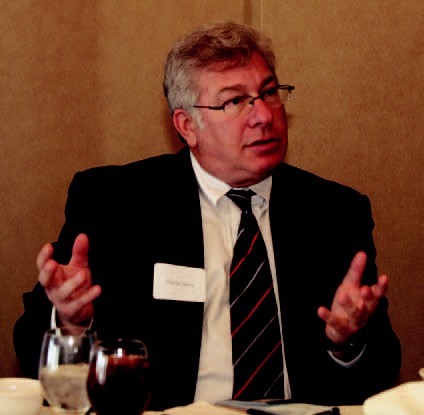Officials prepare to fight Hinkson stormwater regulations | CBT Power Lunch
Millions of dollars have already been spent to clean up the watershed, they say
Local officials are challenging looming federal regulations meant to protect the Hinkson Creek ecosystem, calling them arbitrary and ill suited to clean up the watershed.
The Missouri Department of Natural Resources and the Environmental Protection Agency proposed a revised municipal stormwater permit that includes a provision known as a Total Maximum Daily Load. It requires the city, county and MU to reduce the total stormwater runoff into the impaired creek by about 40 percent. Such reductions would be implemented gradually over a number of years.

“I get the impression the TMDL is a square peg in a round hole in this situation,” said Jeff Barrow, a member of the Columbia Planning and Zoning Commission and the director of Missouri River Relief.
The EPA, though, is under a court order to complete 200 TMDLs by the end of the year, and the Hinkson is one of the last ones on their plate. Unlike most TMDLs, the proposed regulations for the Hinkson watershed do not identify a specific pollutant the community must reduce. Rather, all stormwater runoff would have to be reduced because the regulators believe a single pollutant isn’t to blame for the creek’s impairment.
That rankles local officials in charge of protecting the area’s watersheds.
“EPA has never stated that flow is a pollutant,” said Boone County Stormwater Coordinator Georganne Bowman. “Instead of saying temperature or salt or sediment, now we’re just going to say water itself, the amount of water coming into the Hinkson is the problem.”
She and others questioned whether reducing the overall flow, a process that would likely cost millions of dollars, would actually improve the health of the stream. David Shorr, an attorney with Lathrop & Gage who represents the city, county and MU in dealing with environmental regulators, said an overall reduction in flow could possibly hurt the watershed because pollutants could still be present without the same level of dilution.

Urban runoff, i.e. stormwater, was not included in the original regulations because it is a non-point source. But when EPA realized runoff was often a significant source of pollution, it had the law changed so it could regulate urban runoff as a point source. The Hinkson drains roughly 60 percent of the land area within the Columbia city limits. Urban land use within the watershed has grown from 7.9 percent in 1993 to 20.7 percent in 2005.

The area’s efforts to improve the quality of the Hinkson watershed are working, Houts said. The community has made progress under the existing regulations, as evidenced by the city and county stormwater ordinances as well as cleanup efforts along the Hinkson. However, the TMDL is an “ill fit,” he said.
“All it’s going to do is take all our resources out of a program that probably is doing a really good job of making our waters better and make us throw all our resources into something that was never designed to do what it’s now being issued to do,” Houts said.
Although participants agreed that the TMDL is not the best way to clean up the creek, Boone County Smart Growth Coalition Chairman Ben Londeree said some sort of mandate is necessary.

Shorr said the EPA has acted as if the community has not invested anything into improving the watershed. The county has closed sewage treatment plants in the watershed. The city has passed a multimillion-dollar bond issue to eliminate old sewer lines and improve others in the watershed.
“We’re talking real money,” Shorr said. “It’s at a minimum $20 million and potentially as high as $40 million that’s been invested by all the partners (in the stormwater permit).”
The public comment period for the TMDL ends Nov. 30, and Shorr said the EPA generally takes about a month to respond. Shorr is skeptical that the EPA will listen to the arguments from the permit-holders. After reviewing the comments from the public and the EPA, the city, county and university will make a decision on whether to challenge the TMDL in federal court, he said.
That challenge, Shorr said, will likely pose two questions for the court: Did the EPA act arbitrarily, and did they fail to listen to the community?
“The answer on both, from our perspective, will be yes,” Shorr said.

“We support the objective,” Shorr said. “We just don’t like the path.”
Power Lunch Participants
Presenter:
Karen Miller; Boone County Commissioner
Participants:
Jeff Barrow; Columbia Planning and Zoning Commission
Georganne Bowman; Boone County Stormwater Coordinator
Todd Houts; MU Assist. Director, Environmental Health and Safety
Karen Miller; Boone County Commissioner
Ben Londeree; Stormwater Commission, Smart Growth Coalition
Bob McDavid; Mayor, City of Columbia
Kurt Schaefer; Missouri State Senator, District 19
David Shorr; Attorney, Lathrop and Gage; Co-Host,
CBT Roundtable
Trent Stober; P.E., Geosyntec Consultants
Bill Watkins; Columbia City Manager
The Callaway Bank:
Gary Meyerpeter; President, Boone Co. Market
Debbie LaRue; Vice President, Marketing
Craig Brumfield; Business Development Officer


